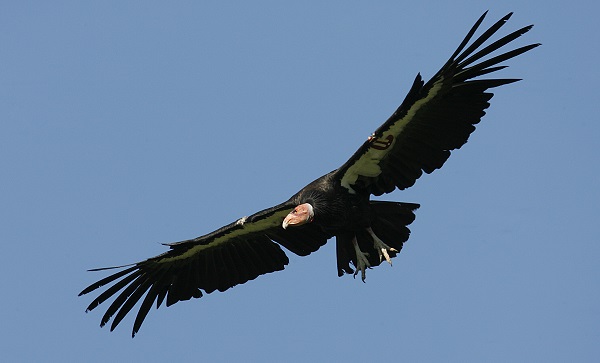For the first time, U.S. wildlife officials have backed construction of a wind power plant with a provision that allows for the death of an endangered California condor.
Conservationists said the decision to grant a right-of-way to Terra-Gen for the 153-megawatt Alta East wind power project in the Tehachapi Mountains north of Los Angeles – with a “take” permit for one bird over the course of a 30-year lease – could threaten recovery efforts for the condor.

The California condor, with a wing span approaching 10 feet, nearly went extinct in the 1970s, its worldwide population falling below two dozen. A captive-breeding-and-release program has nudged the population to nearly 400 total in the wild and captivity.
While conservationists expressed fear, the government cast the take-permit decision in exactly the opposite terms. Officials noted the site is not one suited to condors and listed numerous protection and mitigation measures agreed to by Terra-Gen, which operates several-hundred megawatts of wind power in the region.
“This is a positive step as we continue to support the conservation and recovery of condors,” Ren Lohoefener, regional director for the U.S. Fish & Wildlife Service’s Pacific Southwest Region, said in a statement. “This project provides a basis for future consultations and an opportunity to engage other renewable energy companies and stakeholders with best practices that support condor recovery.”
Wildlife officials believe condors will be at little risk at Alta East, on 1,999 acres of public land and 593 acres of private land three miles northwest of Mojave and 11 miles east of Tehachapi. It’s not an area where the bird has historically hung out, and the site does not offer the sort of thermal updrafts that it likes to soar in.
In addition, the Bureau of Land Management said, the Alta East project was reduced from its originally proposed 106 turbines to 51. Terra-Gen also agreed to undertake “comprehensive condor detection and avoidance measures that greatly reduce risks to condors,” the BLM said. Initially, the wind farm will use a VHF-detection system and curtail operations if a bird is noted nearby. The Fish & Wildlife Service anticipates moving away from putting transmitters on the birds in the future, however, which means that Terra-Gen at some point will have to develop an alternative detection system, such as radar.
According to the Fish & Wildlife Service, “To date, there have been no documented condor collisions with wind turbines” in California or anywhere. So why go to these great lengths at this point? According to the biological opinion issued on the Alta East development [PDF]:
Collisions with the moving blades of wind turbines are a potential threat as California condors move into areas where wind energy development is expanding. Several proposed and existing wind energy projects overlap with or are in close proximity to the occupied and historical range of the California condor, including but not limited to, the Tehachapi Mountains, the Sierra Nevada mountain range, and the Salinas River Valley. Because of their communal feeding strategy, a single feeding event within a facility could kill many individuals.
While wind turbines pose something of a theoretical threat to condors, the birds face a long list of other human-related challenges.
Carcasses and gut piles left riddled with lead ammunition poison the birds; the Center for Biological Diversity estimates that of 161 condors released in Utah and Arizona since 1996, at least 38 have been killed by lead poisoning (yet the states refuse to require the use of nontoxic ammo).
Dating back to the early ’90s, when the birds began to be released back into the wild, 11 have died from collisions with or electrocution by power lines.
Breeding condors can ingest things like washers, copper wire, plastic and bottle caps and feed them to their nestlings; this “has been the major cause of nest failure in the breeding population” in California, biologists say.
Two condors have even been shot dead.
Against this backdrop, is a permit to take one condor in 30 years a big deal? The American Bird Conservancy thinks so. It worries about the condor and the broader damage the decision could have on various recovery efforts.
“The Department of Interior has signaled … that it is willing to sacrifice the money and hard work that are spent on private conservation efforts to recover endangered species in order to build wind farms,” the group’s Kelly Fuller said in a statement. “ABC is extremely concerned about the negative effects that this decision could have not only on the condor recovery program, but also on other recovery programs that rely on public-private partnerships, such as for Whooping Cranes.”